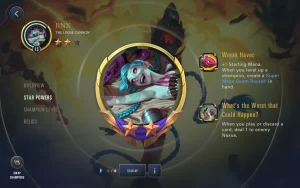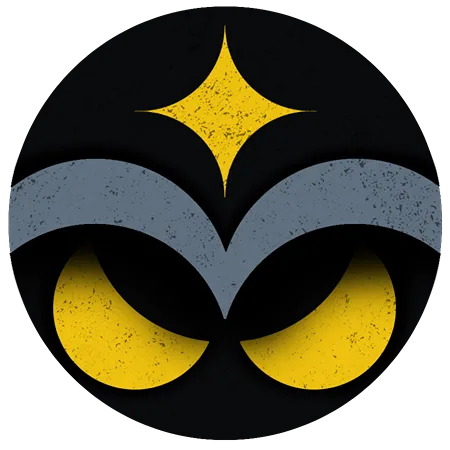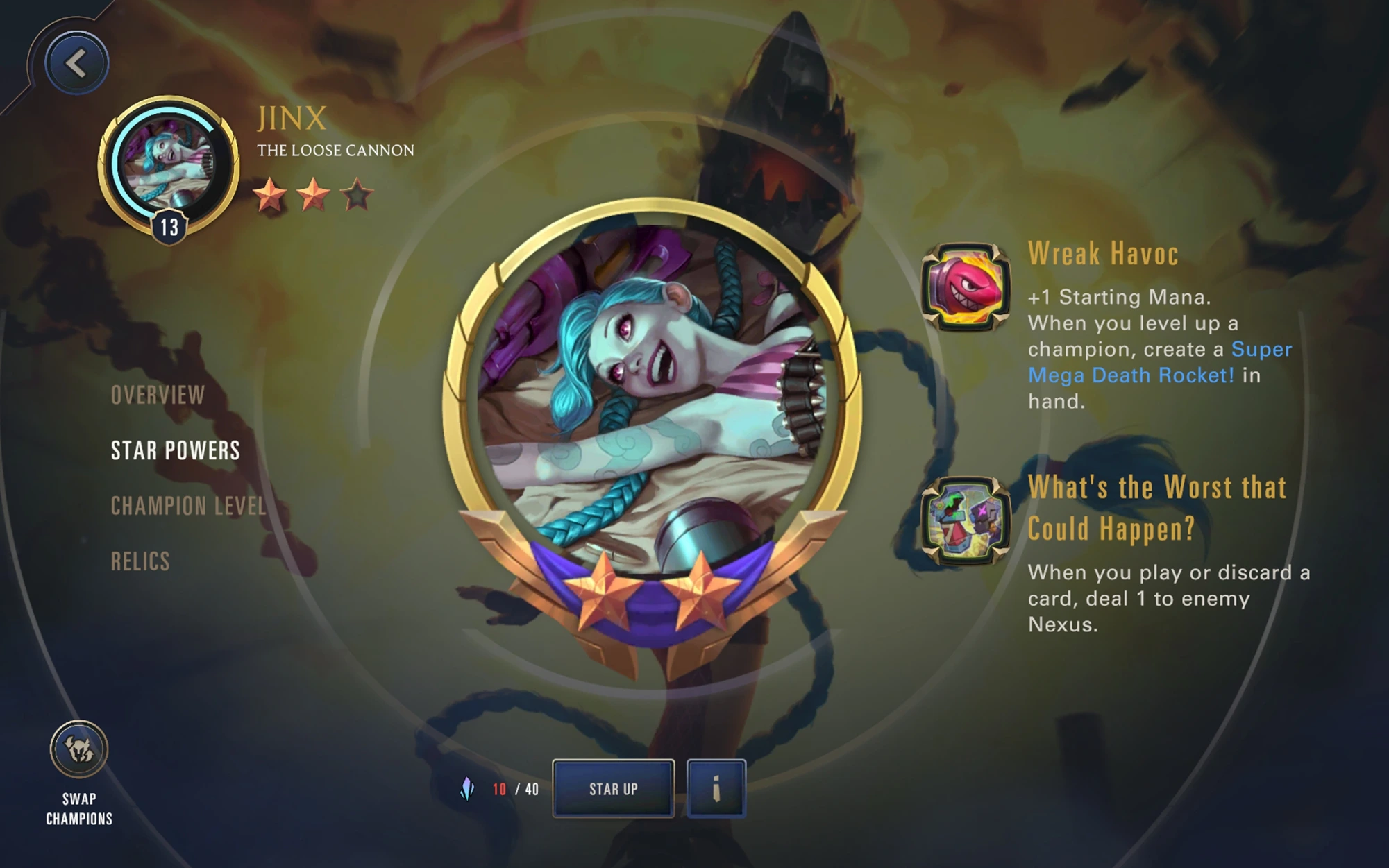First, let's open with the most recent news, which are probably a bit of a downer for those in love with TPOC 2.0:
https://playruneterra.com/en-sg/news/game-updates/we-re-refocusing-on-pvp/
Says Riot: "One of the things we’ve learned is that while The Path of Champions mode currently provides a fun and solid experience, it’s going to require significant investment to expand it to fully become what we envisioned.
So after a lot of conversations and reflection, we’ve decided that rather than continuing to split the game’s focus between core PvP gameplay and The Path of Champions game mode, we want to focus on hyper serving our core PvP player base."
It is indeed a bit weird to hear – three months ago, during the Roadmap reveal, we were told that: "Since its release, players have been consistently spending more time in The Path of Champions than all other game modes combined." – but, well, it is what it is.
The news last Friday did stress that the Path of Champions game mode will remain playable (even if it will receive fewer updates for now), so let's dive in into what we have, then!
A deck-building roguelite, with a bit of squad-based RPG
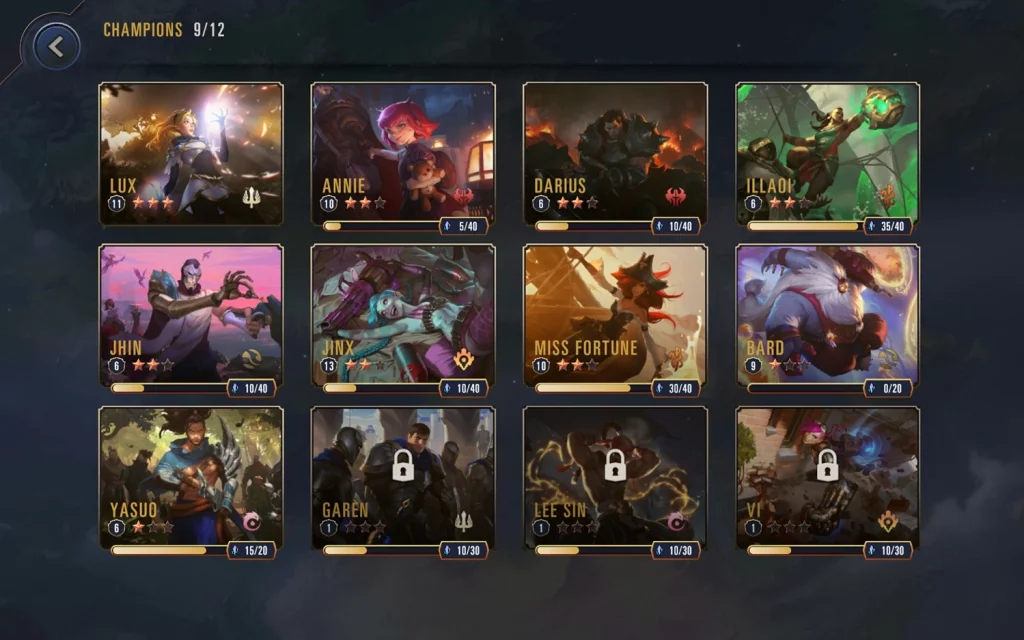
There are two main differences between TPOC 1.0 and 2.0: how your champs grow in power, and that now you need a squad to beat the Bosses.
Later in this article we'll cover in detail how Champ progression works, but at a quick glance here are the four ways in which your Champs get stronger through the game.
Experience/Champion Level:
Pretty much exactly like 1.0 (although the bonuses you get are smaller), and overall what you would expect from any RPG: you beat foes, your character gets XP, XP makes them stronger.
XP only affects the specific Champion, and can only be gained by playing that specific champ.
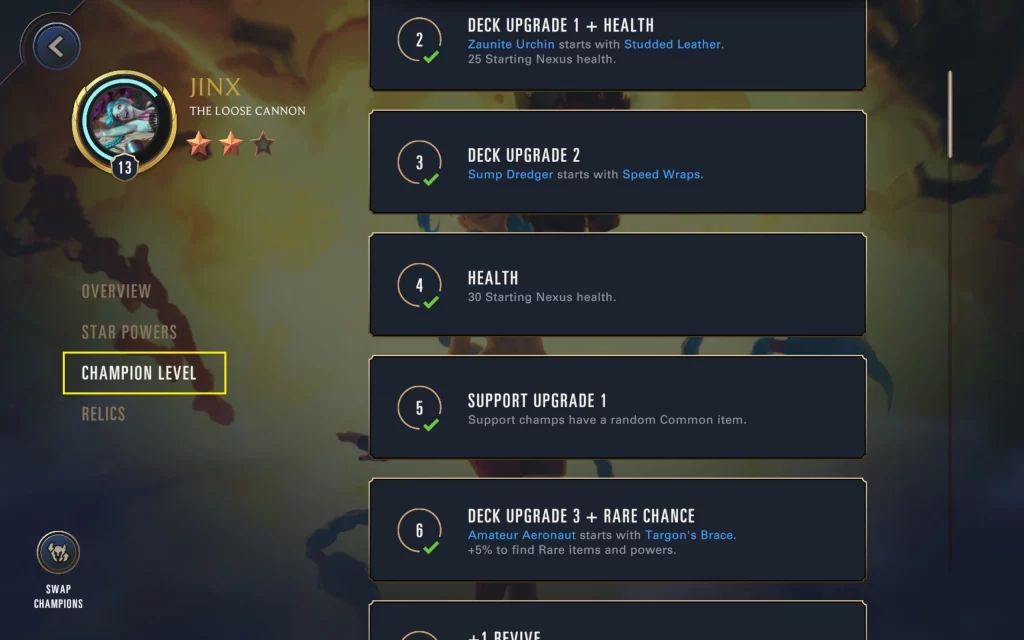
Relics:
These are starting items you can add to your Champ before each Adventure, and are available to all Champions (for example, if you earn a Relic with Lux, Jinx can use it). They work pretty much the same as in TPOC 1.0.
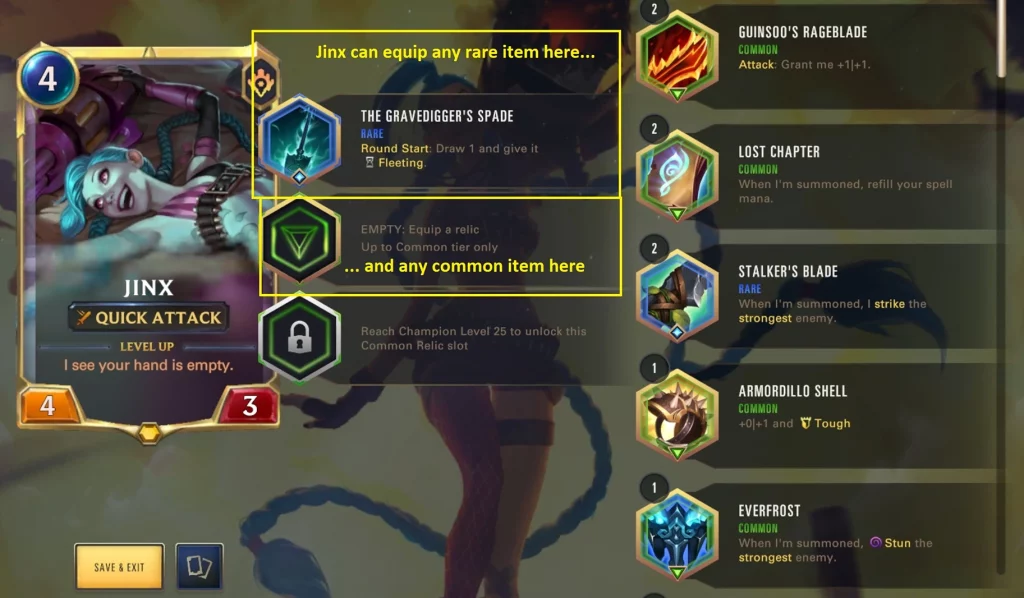
Legend Level:
Your Legend Level affects your whole roster (like Relics, that are available to all Champs).
That is to say, if you reach Legend Level 13 (which unlocks the perk of being able to buy Powers at the Shops), then that's available for all Champs regardless of their experience or level.
This is a new addition to TPOC 1.0, although many of the Legend perks will be familiar to you if you've played the previous version: many used to be perks granted by leveling your Champ via XP.
Star Powers, aka Champion Fragments
During your adventures you'll earn Champion Fragments (by defeating Bosses, and completing Quests), which serve both to unlock new champs, and to upgrade how many Stars (from zero to three) each Champ gets.
Unlike the Relics and the Legend Level, fragments are personal for each champ (if you earn Illaoi Fragments, you can only use them to unlock/star Illaoi, not Jinx or Bard or Miss Fortune).
The power boost granted by two Stars is MASSIVE – an extra Mana Gem, plus extra boni specific to each champ.
Fragments are going to be the main factor deciding which champs you bring to which fight.
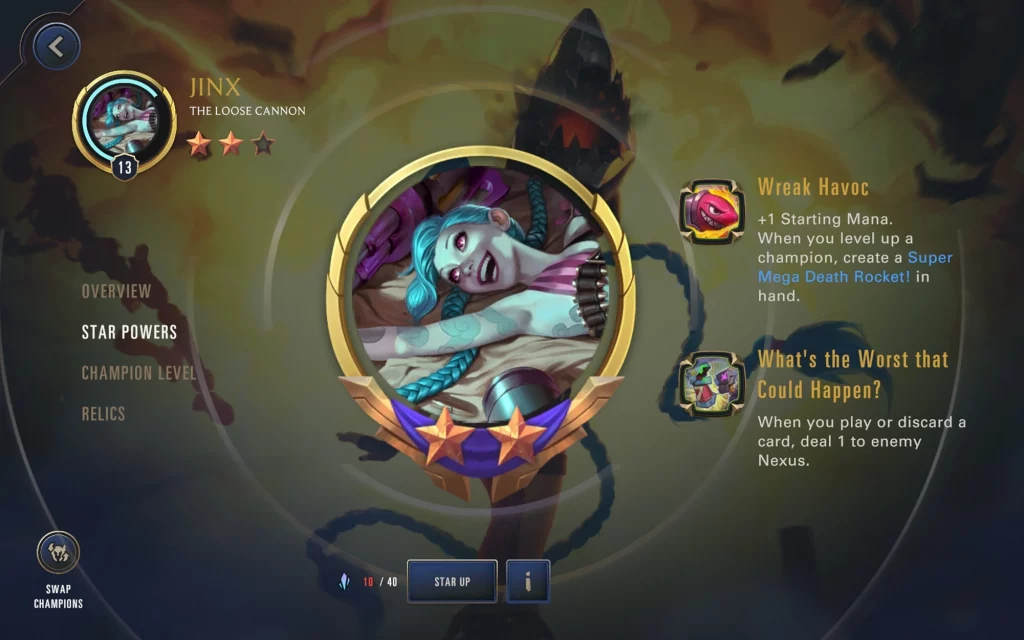
Teamwork
The other – and perhaps the main – difference with TPOC 1.0 is that now you need a bit of teamwork to defeat the Big Boss (which happens to be Galio): in order to unlock tougher bosses, you need to defeat previous bosses with three champs.
As you can see below, in this pic I hadn't beaten the Noxian Boss yet (you can also see my Legend Level when I took this screenshot, on the upper left)…
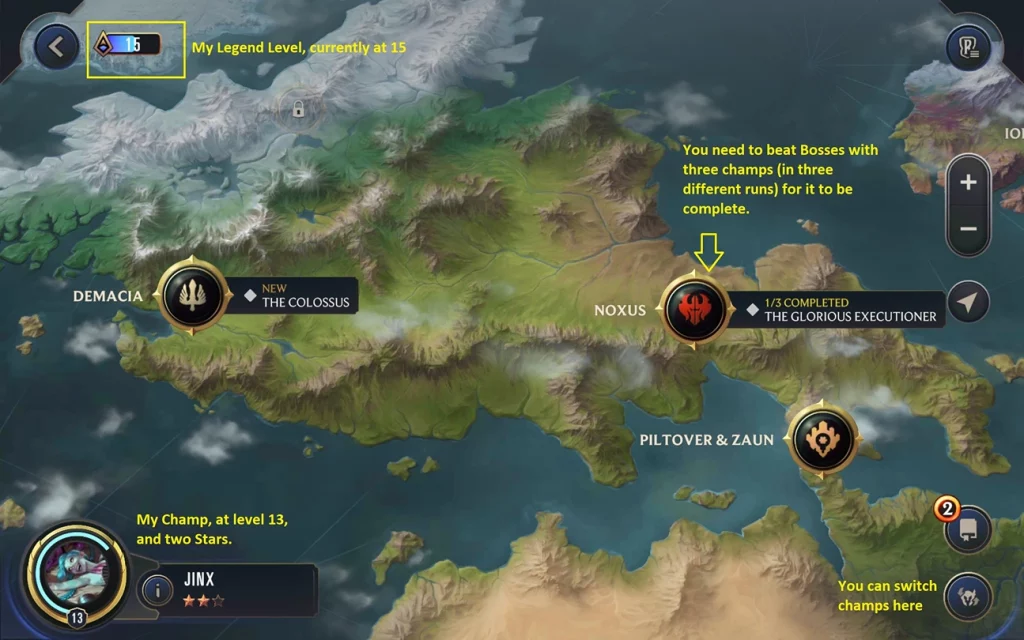
… and several Bosses require you to beat them with three champs, some of them from specific regions, to be flagged as "complete".
Here's Draven, for example:
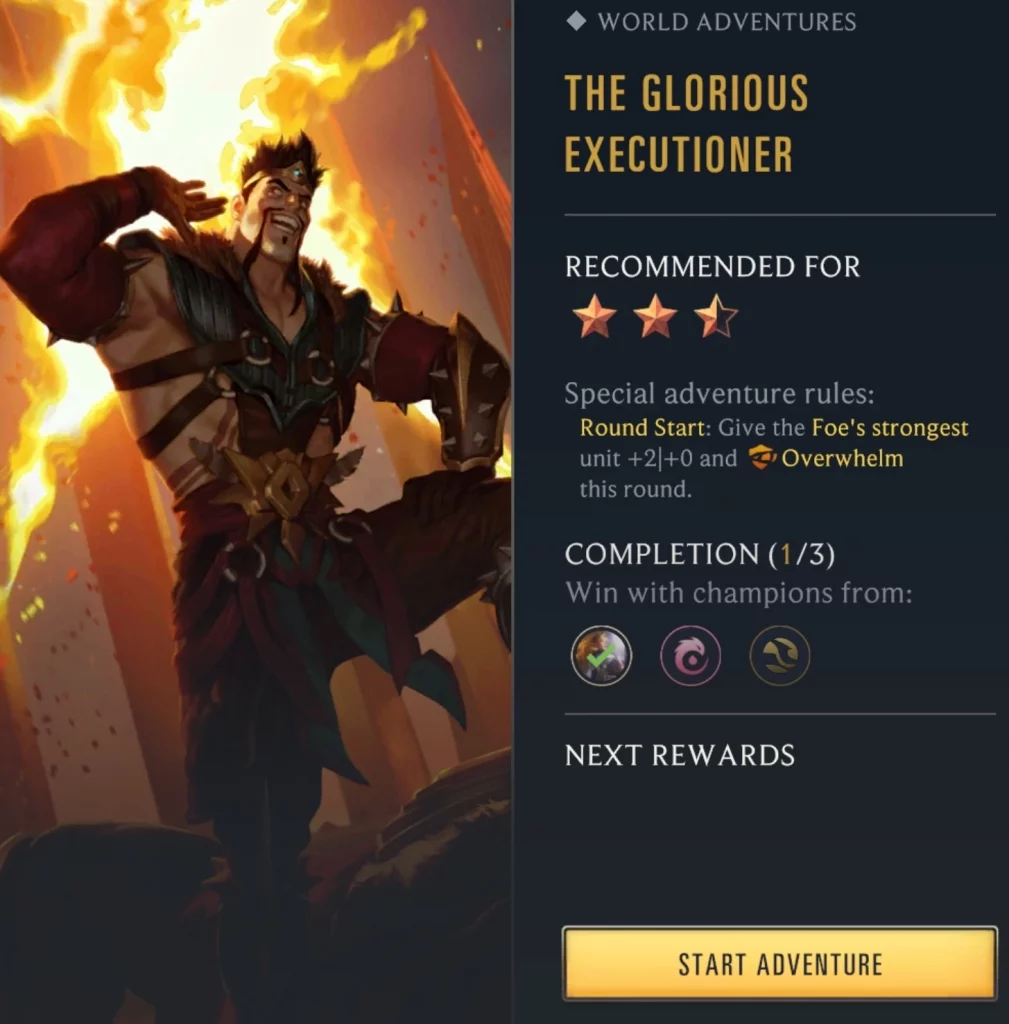
… as you can see, I've beaten him with Lux, but for this Adventure to be complete, I'll need to beat him with a Ionian champ, and a Runeterran champ.
Whereas, as you probably know, Jinx is from Zaun!
In other words: I can still try to crush Draven under a barrage of rockets, but doing so will only gain me XP for Jinx – it won't count towards Draven being completed (so no matter how many times I beat him with Jinx, it won't affect whether or not I unlock Galio next), and won't reward me items or Fragments (which is the reward you get each time you defeat the Boss with the required champs).
This means TPOC 2.0 brings a bit of a squad-based RPG strategy in that, while each Adventure is individual (you cannot bring more than one Champ to each Adventure), there's still a bit of choice and strategy about which champs to use for which job.
Let's dive into these aspects in detail!
Four Ways to Progress
As noted, there are four ways in which you can make your champion stronger (and sometimes play differently): Champion XP, Relics, your global Legend Level, and Stars.
Champion experience
As mentioned above, champion XP works pretty much like in TPOC 1.0, and overall the same way you'd expect in any RPG: champ beats foes, champ gains XP, char gets stronger.
There was perhaps a bit of a missed opportunity here from the point of view of design, in that there are no skill trees (like you find in most RPGs proper; think Diablo, for example). That is to say, from the PoV of XP, your level 13 Jinx will be exactly the same as mine – there's no such thing as comparing builds in this regard.
And, as such, there's not much agency or strategy involved (other than grinding XP to make the character stronger) – a bit of a lost opportunity, in my opinion, because it would have been grand if at least some of these levels unlocked interesting choices.
If you played TPOC 1.0, you'll also notice:
- Many of the perks we used to have here are gone – often because they were relocated to other progression systems (either the global Legend Level, or the Stars). For example, being able to cut cards at the Healer is now part of the Legend Level, while getting an extra mana gem is part of the Stars levels.
- There's less randomness (which in this regard I think is a plus) to some of the upgrades – we used to have perks like "one card in your deck gets a random item", now these are specific (for example, at Level 3 Jinx always gets the Speed Wraps item attached to the Sump Dredgers).
Overall, the simplest of progressions systems: it's linear, so not much strategy is involved.
The most important levels are probably Level 7 (you get a Revive, which is a game-changer since you can now lose a fight without your Adventure ending there), and level 8 (you get to equip Rare relics).
Starting Relics
Unlike Champ XP, this is a progression system with a lot of choices.
As you defeat Bosses, and also from Quests, you get random Relics, which you can equip to your Champ before you start an Adventure. These relics are permanent until you decided to change them.

Relics change the game quite a bit, and allow you to tailor your strategy – from granting bonuses while attacking, to stunning a foe when played, to refilling your spell mana, to dealing extra damage.
This allows for quite a bit of optimization. For example, as you can see above, the Gravedigger's Spade is great for burning (when paired with Jinx's star power, which deals 1 damage every time a card is played or discarded), and I'll probably go for Everfrost in the common slot (to stun foes when played) to either stall the game (and win via burn), or go for an aggressive tempo play (by stunning a blocker).
There's a bit of an odd thing in that you can find multiple copies of a relic, which serves no purpose that I know of: you can equip all your champs with the same relic if you want, even if you have a single copy.
Legend Level
Quite a few of the perks that used to be tied to Champion XP (and were therefore unique to that champ) are now unlocked via the global Legend Level, and are enjoyed by all champions in your roster.
This is a pretty big change for when leveling unused champs – for example, I'm currently on my path to leveling Jhin, and in his runs he enjoys all the Legend perks up until 15 (my current Level).
One fairly dumb thing, though, is those perks are not listed in -game – you can find them in this official link from Riot, and to save a bit of time I've copy-pasted them below (I highlighted a few of them, which I think are probably the ones with a biggest impact in the game).
| Level | Reward |
| 1 | 1 Reroll |
| 2 | Chapter Quests unlocked |
| 3 | PoC Daily and Weekly Quests unlocked |
| 4 | Rare adventure content unlocked |
| 5 | Guinsoo's Rageblade Relic |
| 6 | Shop upgrade |
| 7 | Silver Cosmic Vault |
| 8 | 2 Rerolls |
| 9 | +10% Gold acquisition |
| 10 | Healer upgrade – cut cards from your deck (from three options) |
| 11 | 100 Starting Gold |
| 12 | Rare Relic |
| 13 | Shop upgrade – shops sell Powers |
| 14 | Gold Cosmic Vault |
| 15 | Healer upgrade – cut ANY non-champ card in your deck. |
| 16 | +20% Gold acquisition |
| 17 | Gold Cosmic Vault |
| 18 | 3 Rerolls |
| 19 | Platinum Cosmic Vault |
| 20 | Healer upgrade |
What do other players think of these changes?
"Thanks goodness, I'm so glad!" says YouuXun, a completionist that earned an S badge in literally every encounter in TPOC 1.0, with every champ. "It cuts sooo much grind."
Conasson, author of the unofficial LoR rulebook, and who has already milled every TPOC 2.0 encounter to extract the decklists, agrees: "The global Legend level gives just quality of life upgrades," he says, "like cooler powers and better abilities to start, which are often optional (you can just not buy that power at the shop). The same happens with champions' levels gained by XP: they are nice, and they make your deck much smoother to play, but none of them is game-breaking either."
Personally, I tend to agree. The account-wide Legends level does make things easier across the board, cutting the grind of training new champs during their first few levels, and at several points does so by adding new choices (rather than a fixed, flat "Here you go, Champ, you're stronger now!" boost to some stat).
The perk at Legend Level #15, for example (which allows you to cut ANY non-champ card at the healer), for example, is exactly the kind of choice I'd expect from a deck-building game, so I really like these perks to be global.
Star Powers, on the other hand..
Starstruck
"Awful," says YouuXun the completionists, when asked about the new Champion Fragments you need both to unlock new champs, and to increase their Stars. "RNG bad."
"It is hard to control how to grind the champs when you get shards at random," agrees Horsea, who played every PvE mode extensively. "I really loved 1.0 – it was a fun experience, like playing an RPG adventure game, but with cards instead. I also played the original Lab of Legends and think it was good, very good. But we got no progression for our champs (we just got random powers and perks that only lasted a single run), therefore I love TPOC much more.
"I'd say TPOC 2.0 is good, but fragments really feel off. I don't really mind that we can't just play the champ we love from the very start – but having RNG decide whose fragments we get is really making me uncomfortable."
"The random nature of the stars progression is pretty awful," says Alkaloid, who played tons of TPOC 1.0 runs with Jinx. "I played TPOC 1.0 with the express purpose of getting SSS ranks as fast as I could," he says. "I liked it less than the original Lab of Legends, but the runs were pretty quick once I got Jinx to max level. I haven't played TPOC 2.0 as much yet, but progression seems too convoluted."
"The biggest issue," says rulebook writer Conansson, "is that you can get excess Champion Shards on a single champ that is already at three stars. And if that happens, shards are wasted and it feels bad. This is the only complaint I've heard so far though, which is an amazing sign for the gamemode overall."
From what I've experienced myself (I've just unlocked the final Boss, Galio), the Fragment system is indeed a bit too RNG-y.
If the extremely linear Champ XP system seems like a missed opportunity – going for Slay the Spire when you should have gone for Diablo, so to speak – the Champion Fragments is…
… how shall we put it…
… let me quote some some folks from twitter:
Perhaps in not so stern a tone, but, yeah, kinda...
The weird thing is, it's a bit like they sat down and said: "You know what would be cool!? CARD PACKS!! Like, crafting the Champs you want is, like, boooring, right? So, let's make that totally RANDOM!!"
— Herko Kerghans (@HerkoKerghans) June 1, 2022
The Fragment system feels really clunky in my opinion, and I guess its problems can be summed up in three words: almost zero agency.
Basically:
- As you defeat Bosses and complete quests, you'll get Champion Fragments – those Fragments are individual for each champ.
- Once you get 30 fragments, you can unlock that champ,
- Afterwards (at 10, 20, and 40 fragments) you can take your champ to 1, 2 or 3 stars.
- The power spike from 2 stars is MASSIVE.
- Fragments earned past 3 stars are wasted.
So, to begin with: very little player agency. The game will roll a dice and decide which champs you get to unlock, and which champs you level.
But, it gets a bit worse: as we saw above, the game requires you to level-up a whole squad of champs, since many bosses require you to defeat them with three champs (some of them from specific regions)...
… yet there's not much you can do about which Champs are (literally) the Star of your show: the game will decide for you. It's certainly puzzling (and perhaps frustrating) that there's no apparent correlation between champion XP, and stars.
As a visual example, here's how my current roster looks like:

Cases in point:
- I have two Noxus and two Bilgewater champs at 2 stars, while I only have one Ionia champ unlocked (Yasuo), and at only 1 star,
- Jinx is my most played champ (as seen by her being level 13), yet is behind Lux (already 3 stars), Illaoi and Miss Fortune (at 2, but almost at 3). In particular, notice how Illaoi is just level 6 – it was Nagakabouros, not me, that decided she should be stronger than Jinx,
- You wouldn't be able to tell it from this screenshot, but Bard was the first Champ I unlocked (Jinx is available right from the get-go), and at some point my highest-level champ… yet the stars were not aligned for him, and I could never get him past that first star.
The case of Bard is particularly relevant: you need one Runeterra champ (either Bard or Jhin) to defeat Galio – given the huge power spike when getting 2 stars, that means that in my case, I'll be forced to go with Jhin rather than Bard for the final act.
There's a case to be made that this system provides folks with a challenge (nudging you out of your comfort zone, by making you play champs you wouldn't have gone with otherwise), and once you have Galio unlocked you can take a one-star (or zero-star, even!) champ and try to beat the final boss with them (unlocking "Darkest Dungeon" mode, so to speak, since that roguelite allows you to take untrained characters straight to the final dungeon if you so wish).
"As a more advanced player," says YouuXun, "this system encourages me to skip the grind by playing champions that are vastly weaker than what was probably intended to beat the encounters. I like that challenge. But for newer or lower skilled players, I could easily see how it has the potential to become a grind to unlock, or in some cases, impossible due to the champion shard unlock system."
And there's going to be a number of folks (a tiny minority, for sure, but statistically not zero) that don't even get Jhin or Bard unlocked, which are mandatory for Galio – in that case, RNG would basically be telling those folks: "Nope, you are not finishing this game," which sounds a bit off.
One of LoR's selling points in Constructed is that we've got rid of card packs (which is amazing!) and we have a Shards & Wildcard system instead, allowing us a lot of agency in which cards we craft. It's puzzling that Devs decided to go down the "let's make it all random, zero agency" route here.
Anyway!
That's the cards we've been dealt – how should we play them?
Beating Jinx's First Adventure
If you're new to the game, you have to beat this Adventure (at least currently, you won't be able to unlock the rest of the game until you do).
I'll defer to Conansson's detailed how-to, including detailed decklists for each foe in this Adventure, and an overview of how nodes work.
Star Squad
As said above, the main factor by a MILE are the Star powers.
Specifically, the 2nd star – unlocking an extra mana gem (happens for all Champs), plus extra bonuses (each unique) is the biggest game-changer.
Since the game will decide for you which Champs will be the stars of your show (with the added salt on the wound that you'll have to do all the clicks – for the life of me I don't get while a system with no choice will force you through a bunch of clicks to execute that non-choice), I'll just cover a handful of tips to maximize said choices.
- As soon as you unlock a Champ – and even if you are not particularly interested in said champ for whatever reason – I recommend playing their personal quests: whenever you unlock a new champ, they'll also unlock one personal quest (only them can complete it), that will earn you XP, items and fragments (which in turn may unlock or or star-up the champ you do want)
- Same for whenever a Champ reaches 2 stars – their second personal quest unlocks at that point.
- Keep an eye on Quests – some of them will give you a big chunk of fragments for a specific Champion. Those may be the champions that are ideal to get experience with (as in: if you have both Lux at level 6, and Jinx at level 12, both with two stars, and you see from Quests that you'll get enough Lux Fragments to take her to 3 stars, then consider start beating Bosses with Lux rather than Jinx, since Lux will likely be the one you'll take to boot Galio's 3-stars Adventure).
- Keep an eye on Bosses – you only need to defeat ONE boss to unlock the next level. For example, the 2-star bosses are Nautilus and Zed – you only need to defeat one of them (with three champs from the specific regions) to unlock the 2.5-star bosses.
- Unless you're looking for a tough challenge, always play with 2-star champs (once you get them, and as long as they are from the required regions).
- The only sources of fragments are Quests and defeating Bosses with the proper champs – in the latter case, only until they are marked as complete.
In other words: since the fragment system is random, if you want to be frugal/efficient then it's best to first do the "side quests" (the personal adventures of each Champ, that only they can do) as soon as possible, since they may unlock more options for you, and then maximize XP gain for whichever champs the game decides you need to have at 2 or 3 stars.
And pray the RNG gods smile upon you! =)
Tactics
Giving detailed advice for each Champ on each Adventure is outside the scope of this introduction (if you want tips for Jinx's first Adventure, which is mandatory for new players, here's Conansson's detailed guide), but here are a few tips & rules of thumbs.
Remember to equip relics!
No, really: probably my most common mistake is to send Champs half-naked when they get their second slot available.
Also remember to check for new relics you may have gotten, and double-check if your champ can equip Rare relics – some of them are game-changers.
Don't sweat the Adventure powers too much
The first choice while inside an adventure will be to choose between three Powers for that particular Adventure (they will be gone once that particular run ends).
There are for sure some that are better than others (either for every champion, like Rallying every round, to specific synergies, like an extra Fleeting card you draw every round and which works wonders with Jinx to burn foes down), but they tend to be obvious, and they don't have drawbacks.
Try to stack items
During your adventure, you'll get the option to add items to your cards (any card; not just Champs), usually making them more powerful.
(Notice that it's usually, not always – in some odd cases you'll get some anti-sinergy, like spawning Poros while dealing 1 damage to everything, so keep an eye out for that).
Notice that items affect all copies of a card in your deck — that is to say, if there are two copies of Card A already in your deck, and you pick two more copies of Card A, these last two copies having an item, then all four copies of the card will have the item.
And, notice also that Champ spells are also included -- if you add an item to Decimate , then Darius' Decimate will have the same item too, and slapping extra bonus effects on Illaoi's Tentacle Smash
, then Darius' Decimate will have the same item too, and slapping extra bonus effects on Illaoi's Tentacle Smash or Miss Fortune's Make it Rain
or Miss Fortune's Make it Rain can create some really disgusting swings.
can create some really disgusting swings.
Items stack, too. For example:
- You have 3x copies of Card A in your deck, with Item #1,
- As a reward, you pick 2x of Card A, with Item #2,
- Now all five copies of Card A will have both Item #1 and Item #2.
Since items make your cards better, and add copies of those cards…
… and you want good cards in your deck…
… as a rule of thumb, adding items to cards that are already in your deck is usually a good idea.
So, as a very broad rule of thumb, between:
- Adding two copies of a card you don't have, with a very good item, and
- Adding two copies of a card you already do have 2x, with an okay item,
… consider that by choosing 2 you are adding items to four cards in your deck, not just two.
(Needless to say, sometimes option 1 is so much better that you should go for it).
This is particularly true for Champions, since there are specific nodes for them that will allow you to stack your fav champs with items – I have a feeling my easiest runs are when I manage to pimp 'em full of tricks:
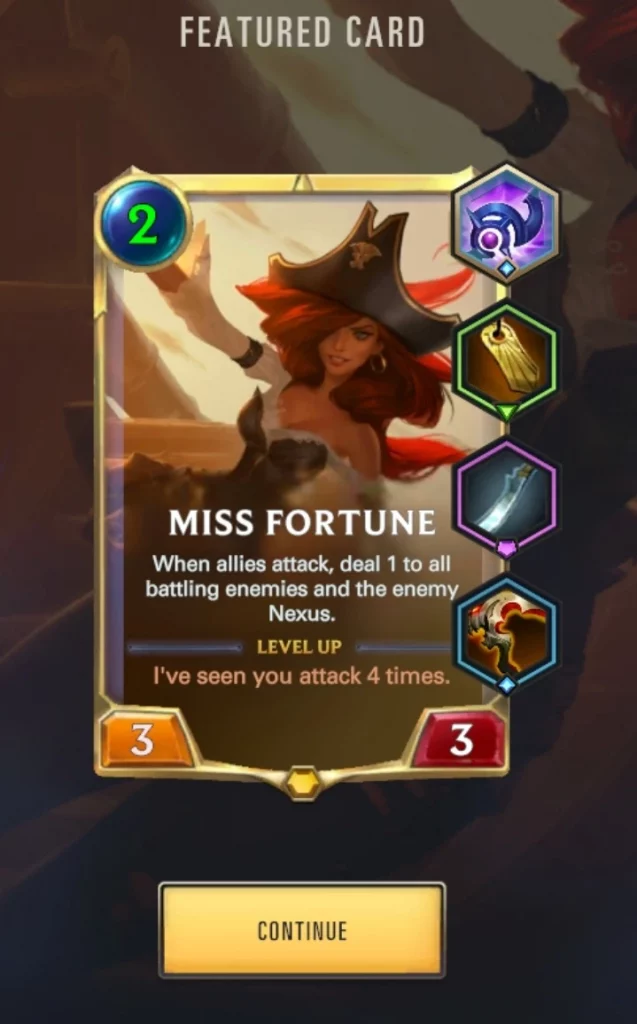
… since each extra item makes an already good card better, while adding more copies of said card.
Last but not least: life gain is VERY good (either by healing, or by life-stealing) – not only it allows you to, you know, survive, but any time you reach a Healer while at high-enough health you can focus on cutting cards, which is also neat.
When to re-roll?
As you progress in the game, you'll be granted additional rerolls for each Adventure – these will allow you to reroll most options (from the first Power choice, to the cards in the shop, to cards you can cut at the healer, etc).
My rules of thumb are:
- I want to keep one reroll available as safety measure for mandatory bad choices – after every encounter you'll get offered a choice between three cards, and you MUST pick one choice to get added to the deck; from time to time, all three will be bad cards, so I'd rather make sure I keep a reroll for those. At those spots, I'm mostly concerned with not adding bad cards (as opposed to trying to add the best card). So, I'll never ever go below 1 reroll just to fish for better options.
- At tougher levels, adding items to cards in your deck becomes more important – I tend to try and save another reroll for the last shop (one or two nodes before the final Boss), in case I need something to round up my deck.
- Earlier choices have the most impact (since they'll be used in more encounters), so with the above two exceptions in mind, I tend to roll aggressively in the very first Power choice.
Experts Recommend…
"Your card selection does not matter as much as your gameplay," says YouuXun. "I see a lot of players asking 'what card should I pick? (kiiky.com) ', when most of the time, what's making them back is not making good plays."
"It is always better to ask the questions when playing against AI," says Alkaloid, "because they aren't good at finding the best answers. Basically: play proactively and aggressively."
"Just stick to whatever champion you hit 2 Stars with first," recommends Conansson. "The 2 star spike is huge and really simplifies the gamemode."
Closing Thoughts
Overall, I find myself enjoying TPOC 2.0 a lot more than 1.0 – I love squad-based RPGs (with Shadowrun: Dragonfall being perhaps my all-time favorite along Planescape: Torment), and TPOC now feels a bit how Dragonfall does when, instead of taking your whole crew on a quest, you can only take one or two characters – that is to say, when the game pushes a bit out of your comfort zone and, instead of taking your well-rounded crew, you gotta go in without your Healing, or without your Tank, or without your Sniper.
Having to plan ahead a bit, and timing when I'll be able to take which champ to which fight, does add a layer of strategy that I love.
The difficulty curve seems much better, both for seasoned players and newcomers. On the one hand, earlier Adventures were made easier (Gangplank is baby Gangplank now, and Karma has been toned down a ton), but since in many cases you can "jump the gun" and bring a low-level Champ to a high-level fight if you wish, I feel both vets and rookies will have a better time than with TPOC 1.0
The above is marred by the, in my opinion, truly awful Fragment system – I have no clue what the Devs were thinking there, but well, it is what it is.
The amount of content is grand, although I'm not sure how much replayability there is: I tend not to care too much about badges personally, so I don't see myself trying to go for an S when I got a C (let alone making it even faster after I did get an S), but a good chunk of folks surely do, and now there's an official timer!
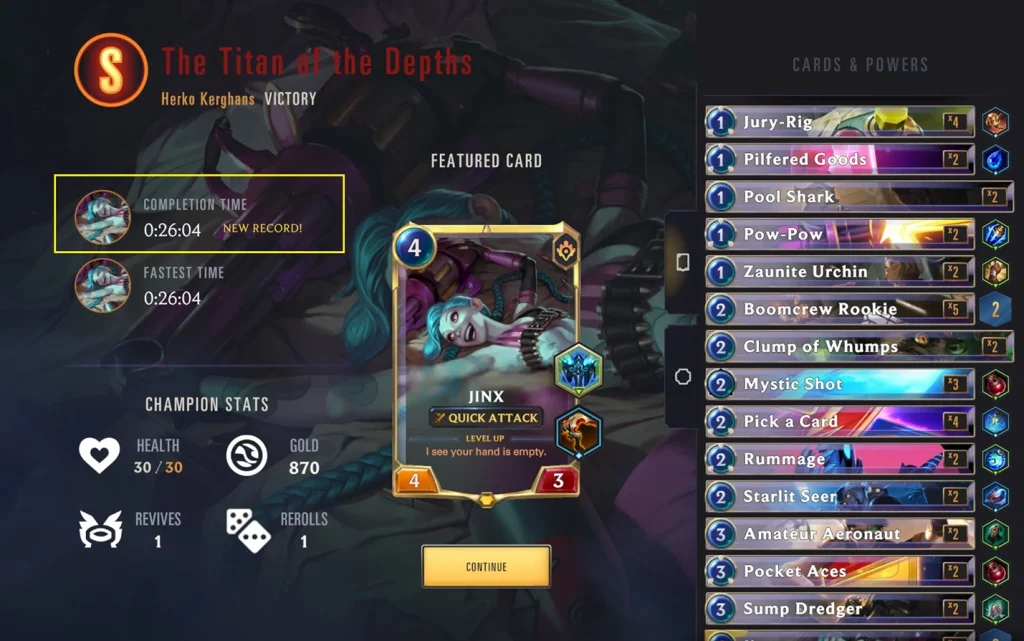
As said at the start, it's a bit of sad news that a game mode that the Devs put so much work into is now apparently on the backburner, but that makes it no different than any single-player game that you may pick from Steam or GoG: you never expect those to receive a stream of new content every other month, and in that regard, TPOC 2.0 does feel like a whole, full game.
I know that, in my case, it will keep me entertained at least until I beat Galio and complete the game, which is more than many other RPGs managed to do.
Good luck with your fragments, remember that playing cards is burn...
… try new things, have fun! =)
Thanks to:
sheldonbunny for catching a typo about the amount of fragments needed to unlock a champ,
itsnotxhad for the clarification about Champ spells getting items too.
